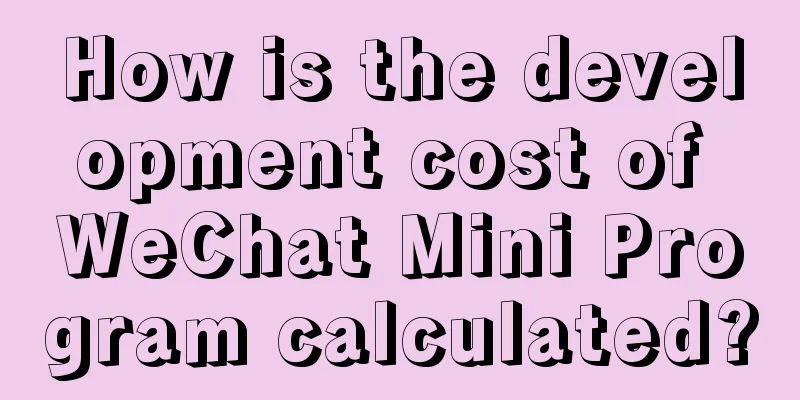I’ve planned a new media event that increased my followers by 330,000. I rely on these 5 steps to run the event successfully!

|
Nowadays, many people like to listen to some practical online courses. Many people are very happy when listening to the sharing, thinking that they have finally heard something practical, with specific cases, and can break down the cases for analysis. Why can’t I plan a good online event after listening to so many useful tips? But when they really want to apply it in their work, a problem arises - they still don't know how to do it. So what is the reason why they listen to a lot of case studies but still cannot put them into practice in their own work? I think it is because every time they listen to sharing, they can only learn some fragmentary knowledge and skills, but they have never built a knowledge system of their own to integrate these fragmented knowledge. I hope that before listening to a lecture, everyone will first have an overall understanding of marketing planning, build their own marketing planning "knowledge tree" and then go to the lecture. Treat the knowledge points in the lecture as branches in the knowledge tree. In this way, your knowledge tree will become luxuriant and fuller, and you yourself will successfully become a marketing planning expert! But I find that most people don't have this knowledge tree. They enter this industry but have no guide to teach them, and are unable to acquire the most critical knowledge to learn. They can only search for some scattered information and learn some scattered experiences on the Internet. Although they feel that they have learned a lot of knowledge, due to the lack of system, they are often still confused when they start to operate on their own. How to plan an event that attracts massive user growth and high conversion rates? 1. What exactly does online event planning do? When many people first enter this industry, they fall into a state: doing activities for the sake of doing activities, and giving out prizes for the sake of giving out prizes. Many people don’t know what the purpose of this position is, what the significance of this activity is, and what its purpose is. Many people don’t know what an event planner position is. I gave it a definition: The status of event planning: talents with little effort and great results Some large companies, such as BAT, 360, JD.com, and Didi, have different definitions of event planning, with many subdivisions. Let’s put them aside and talk about small businesses. ☞ What are the low-cost and effective ways of communication? For small businesses, since they don’t have a high budget and too many resources to support marketing promotion , they need some truly low-cost and effective communication. Generally speaking, there are two ways: 1. There are many ways to spread content through excellent content , such as pictures, text, live broadcast , video, audio, etc. Distributing content through channels is a low-cost way of dissemination. In this era where content is king, if you have good content, it is very easy to spread; 2. Spreading activities through cost-effective activities is a matter of achieving great results with little effort. In our current era, the rise of social media has made activities more and more cost-effective. For startups , it is basically impossible to gather all three major elements: time, personnel, and resources before planning each event. The role of event planning is to cleverly use an attractive theme, a good event format, and very detailed event steps to convey what the company wants to spread to the target users at the lowest cost and fastest speed, so as to achieve the purpose of the event. Therefore, I often say that a very good event planner is the alchemist of the company, because he can "turn stone into gold"! ☞ What abilities does an excellent event planner need? For small companies, leaders often hope that the event planner is an all-round person. Therefore, an excellent event planner needs to have at least the following five abilities: ▲Excellent operations planners should have these 5 abilities ☞ What is a complete planning process like? For a complete event planning process, we should first sort out our internal and external resources: How much budget do we have, how many resources do we have, what channels do we have, and what kind of human costs do we have to carry out this activity? If you want to make a mobile H5 page or a mobile game , you need to understand mobile development and design. You need to understand some UI, some background technologies, know which technologies can be implemented and which cannot be implemented, and you also need to understand some restrictions on your event imposed by WeChat officials or the media channels you use, and you need to know them well. Then, for the relevant copy in the event you are going to hold, whether it is promotional copy or the theme and content of the event page, you must understand what kind of copy can attract people's attention. There may be a dedicated person to work with you to complete this copy, but you must ensure the quality. As an event planner, you are actually a project manager. For example, if you want to showcase an H5 game during an event, you need to coordinate the interests of design, development, testing, communication, PM, PR, etc. You need to control the progress of your project to ensure that the project can be launched on time. Finally, there is planning for the communication path. Many people may think that once an activity is designed, it can be launched - for example, by finding an official public account to push it, and that's it. Is this really communication path planning? Of course not. Now is an era of integrated marketing. We need to preheat and spread our activities through PR articles, third-party Weibo and WeChat, Zhihu, Douban, Tieba, etc. During the event, we also need to disseminate the content produced in the event. After the event, we can also integrate the event data and operation methods for secondary dissemination. We may initiate a topic on Weibo, then hype it through multiple channels and key figures, display the landing page on WeChat, and finally direct it to the APP. This is a complete communication chain. Before you plan the entire communication path, you must think clearly about your activities. Is it for maximizing communication or for driving downloads to the APP? It is definitely not the case that I can just make a page and launch it and everything will be fine. This would definitely not be a good activity. 2. What preparations should we make before starting planning? After understanding all this, we are now going to start planning an event. What should we know before we actually plan to start an event? Is the purpose of our activities to attract more people and make them pay attention to us? Or is it to sell your own products? ☞ Determine the purpose of the activity Before doing an event, we must think clearly about what the purpose of our event is. In different cycles of each product, the marketing objectives and methods are different. In fact, the purpose of activities is generally divided into two types: The first is to expand influence, which is the so-called dissemination, and the second is to direct traffic to our products and ultimately trigger conversion. Whether it is downloading or generating purchases, generally speaking there are only these two purposes. I have seen many activities whose original purpose was to increase the number of downloads for the APP, but in the end they only achieved the effect of spreading the H5 page. The result is that after others have been spreading your H5 for a long time, they still don’t know what you do and have not downloaded your APP. Such an activity is undoubtedly a failure. There are also many people who, after completing an activity, actually achieved very good results, but discovered a problem which was not what their leaders wanted. Therefore, before you plan an event, you must sit down and have a good talk with your leader. Understand clearly what the leader wants to achieve. Because in different communication cycles of your product, the activities and purposes you want to hold are different, so you must confirm with your leader what the purpose of this event is. ☞ Analyze the target population Due to differences in product attributes, event formats, and even communication channels, your target audience must be different, so you must constantly understand the target audience of your event. The deeper the understanding, the better. Many people may say, I know my target group very well, which is women, 25-35 years old, that’s it. Is this really enough? Of course not. We must analyze our target audience as thoroughly as possible and find where the core target audience gathers online to influence them, meet their needs, and let them spread the word for us! ☞ Determine the activity format Find an activity format that suits your activity purpose, target group, and promotion channels. Then you need to create a spontaneously spreadable activity based on the product attributes at the right time. We often hold events at a specific time point that is suitable for our products (such as various festivals). After selecting this time node, we need to create an activity that can spread spontaneously. The definition of a spontaneously spreadable activity is: when we reach the target users with our activity information through various channels, they will become curious about the activity and participate in it, and then due to some settings of the activity itself, they will want to share it. After his friends saw the information he shared, they also wanted to participate in the event, resulting in an "exponential growth" in the number of participants in the event! ☞ How to determine the purpose of the activity? How to analyze the target population? I also consulted our product manager about this matter. He said that the simplest way to deal with these two aspects is the 5W2H method: ▲ 5W2H analysis method For example, we recently launched a new watch "Badilong Children's Watch". We need to make a pre-marketing marketing plan. Let's use the 5W2H analysis method to analyze it: What: It is a complete marketing plan before the launch of "Budilon Children's Watch". Why: We want to make everyone curious about the "Buddyon Children's Watch" before it is launched on the market, and want to know what kind of product 360 makes. We will reveal some things to arouse everyone's curiosity. It might reveal some parameters, reveal some features, or reveal some things that might happen. Where: We will use multiple channels to do this, including PR, Weibo, WeChat, Zhihu, Tieba, forums, etc. How much: Requires XXX budget and resources, needs help from suppliers, etc. How: We need to make a complete table to write out what we should do in a certain period of time. This table is on the next page. The three aspects including how to do it, when to do it and who will do it will all be presented on our next page. ▲ Gantt chart This picture is invaluable. As I said just now, every good event planner is also a very good project manager, so when you are doing project management, you need to do a lot of things. How to manage so many things? You need this amazing chart - the Gantt chart. When (stage) to do it, through what channel to do it, who will do it, how to do it, etc. can all be reflected in this picture. The development period means that at this time, we need to make some preparations, whether it is copywriting, H5 pages or other aspects. Then we need a certain development period, and after our products are developed, we will enter the warm-up period. Generally speaking, for new projects like this one, or voting activities, they need to put in the most effort during the warm-up period. During the warm-up period, we may need to spread our information through third-party Weibo and WeChat, official Weibo and WeChat, print media, online media, BBS, KOL (opinion leaders, people who have great say in a certain field and are very prestigious) and other channels. Of course, this method is definitely not hard advertising, but it is very skillful. It makes people curious about us, triggers discussions, and maximizes exposure. Then, in the early stage of launch, we may promote some of our parameters and analyze some of our real functional points. Finally, in the long tail period, we will distinguish our various functional points more finely to make everyone more clear about what our product looks like. This picture is a complete Gantt chart. Before you do any activity or launch a new product, make a chart like this. Your colleagues and leaders will know clearly what you are going to do. 3. Let’s make an “activity product” together In fact, I think that everything we do now is a product, and we can use the thinking of a product manager to do it, including ourselves. We ourselves are a very good product. Everything we do, including sharing, articles we write, work we do, and resumes we have, are actually perfecting the attributes of our product and constantly optimizing every aspect of our product. This includes fixing our bugs, increasing the influence of our own products, finding a better home for our products, using better channels to promote our own products, etc. According to this statement, we ourselves are a product and also a product manager, and the same applies to activities. In fact, when we organize activities, we will eventually find that the types of activities everyone does are actually similar. Everyone must have heard the saying "There's nothing new on Wall Street." Human nature will always be the same and will never change. What we want to do is to use the characteristics, or weaknesses, of human nature to create our own products. Of course, it is impossible for everyone to make a very successful product right from the start. We may start by doing a relatively basic activity, and we will find that there is a problem in a certain link, or that a certain channel is not effective. Then we can avoid these problems the next time we do the activity. At the same time, we must make some micro-innovations and continue to iterate. Only in this way can we do a better job of making our activity products. Since we treat the event as a product, we are now a product manager and we are now entering the role of a product manager. The first one is a logic diagram, which is used to tell our design and technology about the forms through which our current activities should be implemented. For example, when I click a button at the beginning, what will happen after I click it: it may be a network error, it may be the situation of entering the next page, or there may be a bug. We need to consider all possibilities. Whether you want to allow users to get another chance after sharing, or let others enter other different pages after users share, you must reflect it in this logic diagram. The second one is a prototype. A prototype is to draw what you want to present in your mind. It is just a tool to help you. Just use Axure to do it. Don’t think that Axure is very difficult. If you know how to use PS or PPT, using Axure is very simple. ▲ What are the characteristics of activities that have exploded in the circle of friends? This picture is actually what I spent more than an hour sharing at Mantou Business School . It talks about the nine characteristics that will make your circle of friends explode. As a PM, many people have seen some jokes about: PM fighting with design, PM fighting with technology, PM fighting with operations, all kinds of fights! In fact, the best way to avoid conflicts is to communicate more effectively! ▲ The love-hate relationship between operation, design and products The reason why PM has conflicts with design and technology and operations is often due to insufficient communication. For example, before doing an activity, I suggest you follow this process: First, I come up with my own plan. Then, before actually giving the requirements, I pull all the relevant personnel in design, technology, and operations into a conference room to have a talk and ask for everyone's opinions. If I feel that I am not doing a good job, do they have any ideas? This is instead of just giving requirements without saying anything. You are not someone else's leader; you are all colleagues. Everyone wants to do their job well. Let's communicate with each other about how to do it better. This is the art of communication. If you hold this kind of meeting, you will find that no one will be disgusted with you. Because you respect their opinions, and you have sought their opinions and obtained their approval before formally making a request, then generally speaking, conflicts will be reduced a lot. So before doing any project or activity, everyone must pay attention to effective communication! 4. Integrate resources and spread the activities When the main framework of the activity is basically completed, the next step is how we spread it. ☞ Integrate internal and external resources ▲ What should we pay attention to when integrating external resources? What does the integration of internal and external resources rely on? I think three questions can make it clear: What do you want me to have? What do I want you to have? How can we achieve our common goal through resource exchange in this activity? Of course, there are many other factors involved. For example, whether your company, products and you are well-known and influential. If so, more companies will definitely actively seek cooperation with you. Such factors include human relations, affinity, communication skills, appearance, etc. In fact, negotiating cooperation is like dealing with people. If you can make him feel that he has made more profit this time, he will come to you for cooperation next time and will introduce more partners to you! Doing things is like being a person. Give more benefits to others, and this way others' appreciation and reputation will increase. But if you always want to take more from others, you will have no friends and others will not be willing to cooperate with you. ☞ Prepare materials ▲ What materials do we need to prepare? Before we officially promote the event, we must prepare our materials in advance, and not wait until the event starts to prepare them. In fact, a lot of materials are actually templated and predictable. For example, when we plan an event, we will inevitably set many time nodes. We must prepare pictures and texts through new media , third parties, forums, PR drafts and other channels before the event starts. When the time comes, we can just add a picture from our event, slightly change the text and send it out. Don’t wait until the day of the event to do it, everything should be prepared during the event planning stage. ☞ Why does an activity explode? Many people often ask: Why is the activity I organized not popular? Why are activities organized by others so popular? Is it because of other people's good luck? Was it because of the right time, right place and right people that he caught up? Never trust luck, the success of an event depends on the "trigger point"! More than 90% of the time, an event can be successful because it has hidden one or more trigger points in the event. It is not just luck that makes the event successful. The probability of this happening is very low! Take the recently popular "4-hour escape from Beijing, Shanghai and Guangzhou" as an example. Regardless of whether this event achieved the brand's goal, let's analyze why this event became popular? I think he had two triggers: ① The ever-increasing housing prices and population base in Beijing, Shanghai and Guangzhou have caused a sharp deterioration in the cost of living and competitive pressure in first-tier cities, making escaping from Beijing, Shanghai and Guangzhou a hot topic that is mentioned from time to time. This event successfully used this topic to attract the public's attention and arouse the public's yearning for "a trip that can be taken at any time." ② The literary content, randomly going to an unknown place, and completing an interesting task (such as meeting a Miss Dong to eat ramen, taking photos with five animals, etc.) are all stirring the hearts of literary young people and white-collar workers, making them yearn for it! Of course, this event, which was supposed to highlight the brand, ultimately turned into a self-entertainment for the marketing company, which left me speechless. (Once again, I want to emphasize the importance of the purpose of the activity!) ☞ After the event starts, secondary dissemination should be done well First of all, you need to monitor the activity data in real time and make corresponding adjustments to the details and parameters of the entire activity at any time. Depending on the type of event, you may also need to communicate with the 20% of people with the highest event participation to understand their opinions and views on the event so that you can make adjustments to the event, tilt traffic, and perform other operations at any time. Because only when you maintain this part of users well can they help you introduce more traffic. It seems that we are helping them become the top users in the entire activity, but in fact they will also introduce more traffic for you. All social products are the same. Why does Weibo want to attract celebrities, including the recent Zaixing and Fenda , why do they want to attract celebrities to join? It’s all the same marketing idea. Then, you also need to organize some good materials such as photos, videos, audio, text, etc. generated during the event and disseminate them through official or third-party platforms. Because only when the content generated during the activity becomes popular, can this activity become truly popular! 5. How to review the event after it ends? The event is finally over, can we go eat hotpot and sing songs now? Of course not, although the event is over, your work is not over yet! Because you need to organize the activity data and review and analyze the entire process! ☞ Why do we need to review? If you have done an H5 campaign, you need to take a look at the data of your H5 campaign, the reach rate, which page has a problem with the reach rate, and how to improve it? ▲ A game page For example, in the picture above, there are only 3 pages in total. The first page is the activity start page, the second page is for selecting gender, and the third page is where the real fun begins. You can see that by the third page, its reach rate has dropped to more than 60%. So how can we increase its reach rate and reduce its churn rate? How should we change our copy? Where should we put our button? When testing reach rates, many small businesses will make multiple versions at the same time, and then try them out using many small channels, and then launch the version that works best. Large companies may not have time to use channels for testing, but if you have done a good campaign this time and have a relatively large amount of complete data, you can analyze it to see which details are handled well and which copywriting is poorly written. Analyze carefully, learn from experience, communicate with colleagues, and let them point out some problems to you so that you can make improvements next time. Since we say that organizing an event is making a product, then it is a product that can be iterated. The experience you gain from each activity can be carried forward to the next one. You need to constantly analyze and accumulate knowledge instead of starting from scratch every time. In fact, when we are planning events, every event is a very valuable experience. We should all write it down and make corrections and micro-innovations next time. Then, maybe our next event will be better, we may be able to get more resources, and we can create a case that truly sensationalizes the industry! ☞ 4 steps to review ▲ Four steps to review When it comes to reviewing a situation, I can’t say that I’m particularly proficient in it, so I’ll just tell you the four steps of reviewing a situation. 1. Review your goals. Have you achieved your goals? Have you received recognition from your leaders? Has your expectations been met? 2. Evaluate the effect. Analyze the effect of your activity through data. For example, if your goal is to spread, then what is your dissemination volume, whether your brand exposure is successful, how much your micro index has increased, and how much your Baidu index has increased. If your goal is to drive APP downloads, then you need to see how many effective downloads it brings. 3. Analyze the reasons and find out which details are done well? What went wrong? Why was the event successful? Why did this event fail? What is the reason? You need to analyze them one by one! 4. Summarize the experience and record the analysis process and conclusions of the previous steps, and write review notes so that you can review them when planning the next event to avoid repetitive mistakes. The parts that have been proven to be effective can be reused next time and transformed to be more successful! The concept of "review" originated from the U.S. military's combat methods and was later introduced to China as a corporate review method. We should review everything we do, whether you are doing an activity, doing things, or being a person, you need to review it and go through these 4 steps: review goals, evaluate results, analyze causes, and summarize experiences.
|
<<: Douyin Dou+ sales: I spent 30,000 yuan to gain the experience of marketing!
>>: While promoting the app, the daily activity is decreasing?
Recommend
How to plan an efficient App marketing operation plan!
In recent years, mobile Internet has developed ra...
Dry and cold in the north VS wet and cold in the south, which one is colder?
Mixed Knowledge Specially designed to cure confus...
Take stock of the brand marketing strategies spawned by anxiety!
• Introduction• The tiny cracks in human nature a...
Why do sandstorms always occur in spring?
Audit expert: Ye Haiying Deputy Director of the N...
If you don't wash it for a week, it will be dirtier than the toilet. How dirty are beauty sponges? How should you choose one?
For those who often wear makeup, beauty sponges a...
What kind of H5 page will trigger chain transmission?
Countless people have quoted Dickens's words ...
Does "overnight food" mean food that has been left overnight? Not necessarily! It is best not to leave these two foods overnight →
It is said that "thrift is a traditional vir...
"Pouring water to make ice" makes the winter atmosphere full, be careful not to get hurt
The recent cold wave sweeping across the country ...
2015 Chinese Programmers Survival Report—How miserable life is!
Coding at work, coding overtime, and falling asle...
Domestic mobile phones are priced at less than 4,000 yuan? It’s all due to the price-performance ratio
Domestic mobile phones have always been overwhelm...
Lao Wang from the west of the village: A training camp to teach you how to make lessons (completed) worth 799 yuan
The course is divided into 5 chapters (the underl...
Better than the built-in file manager in Windows 11? Files App
I think everyone is using Windows' file explo...
App Annie: Total app store downloads are expected to reach 130 billion in 2020
According to the year-end forecast of mobile data...
How to combine new product marketing strategies with big data?
The strength of a country's economic soft pow...
I was playing ham radio in the park and was mistaken for a spy
"CQCQCQ, this is BH9EMQ, calling friendly st...









